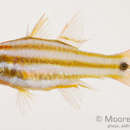en
names in breadcrumbs


Die Kurterartigen (Kurtiformes) sind eine Knochenfischordnung aus der Gruppe der Barschverwandten (Percomorphaceae). Es sind meist kleine Fische, die bodenbewohnend oder bodennah im küstennahen Meer, seltener im Brackwasser oder in küstennahen Süßgewässern, leben. Zu den Kurtiformes gehören nur zwei Fischfamilien, die namensgebenden Kurter (Kurtidae) und die Kardinalbarsche (Apogonidae) mit über 25 Gattungen und etwa 350 Arten. Die nahe Verwandtschaft dieser beiden Familien gründet sich heute ausschließlich auf molekularbiologische Untersuchungen. Die Schwestergruppe der Kurtiformes sind die Grundelartigen (Gobiiformes).[2][3]
Sowohl Kurter als auch Kardinalbarsche sind seitlich abgeflachte und fast immer mehr oder weniger hochrückige Fische. Fraser kann bei seiner Beschreibung der Kardinalbarschgattung Taeniamia keine gemeinsamen Merkmale der beiden Fischgruppen erkennen,[4] aber schon 1993 bemerkte der amerikanische Ichthyologe G. David Johnson eine bemerkenswerte Ähnlichkeit zwischen den oberen Kiemenrechenelementen (dorsal gill-arch elements) von Kurtus und denen der Kardinalbarsche. Der russische Ichthyologe A. M. Prokofiev wies 2006 auf die ähnlichen Bauchrippen und Afterflossenpterygiophoren von Kurtus und einer Kardinalfischart (Archamia bleekeri) hin und vermutete eine enge Verwandtschaft der Fische.[5] Ein weiteres gemeinsames Merkmal sind die mit Filamenten ausgestatteten Eier, die dadurch zu einer lockeren Masse miteinander verbunden werden und so von den Kurtus-Männchen an ihrem Supraoccipitalhöcker am Hinterkopf bis zum Schlupf der Jungfische mitgeführt werden können, während der verbundene Eiklumpen den männlichen Kardinalbarschen das Maulbrüten erleichtert.[6]
Die Kurterartigen (Kurtiformes) sind eine Knochenfischordnung aus der Gruppe der Barschverwandten (Percomorphaceae). Es sind meist kleine Fische, die bodenbewohnend oder bodennah im küstennahen Meer, seltener im Brackwasser oder in küstennahen Süßgewässern, leben. Zu den Kurtiformes gehören nur zwei Fischfamilien, die namensgebenden Kurter (Kurtidae) und die Kardinalbarsche (Apogonidae) mit über 25 Gattungen und etwa 350 Arten. Die nahe Verwandtschaft dieser beiden Familien gründet sich heute ausschließlich auf molekularbiologische Untersuchungen. Die Schwestergruppe der Kurtiformes sind die Grundelartigen (Gobiiformes).
The Kurtiformes /ˈkɜːrtɪfɔːrmiːz/ consist of two extant families of ray-finned fish, the Indo-Pacific Kurtidae (consisting solely of two species in the genus Kurtus) and the much more diverse and widespread Apogonidae (the cardinalfishes). The order is part of the Percomorpha clade and is regarded by many authorities as a sister taxon to the Gobiiformes.
A close relationship between the Kurtidae and Apogonidae was postulated based on the similarity of constituent parts of their dorsal gill arches and that in both groups the eggs have filaments on the micropyle, which enable the eggs to form a mass. This mass is brooded in the mouth in the Apogonidae and borne on the supraoccipital hook of at least one of the two nursery fishes in the Kurtidae. They also have horizontal and vertical rows of sensory papillae on their heads and bodies, which are often arranged in a pattern resembling a grid (similar patterns of sensory papillae can be observed in some species in the Gobiiformes). The two families comprising the Kurtiformes are recovered as sister groups in some molecular phylogenies, but others instead recover them as successive sisters to the Gobiiformes.[2]
Two extant families are classified under the order Kurtiformes:[3]
The Kurtiformes /ˈkɜːrtɪfɔːrmiːz/ consist of two extant families of ray-finned fish, the Indo-Pacific Kurtidae (consisting solely of two species in the genus Kurtus) and the much more diverse and widespread Apogonidae (the cardinalfishes). The order is part of the Percomorpha clade and is regarded by many authorities as a sister taxon to the Gobiiformes.
쿠르투스목(Kurtiformes)은 조기어류 목의 하나이다.[2] 이전에는 농어목에 속하는 쿠르투스아목(Kurtoidei)으로 분류했다. 인도-태평양에서 발견되는 2종을 포함하고 있는 쿠르투스과와 전세계에 널리 분포하는 동갈돔과로 이루어져 있다. 망둑어목 어류의 자매군이다.
2016년 현재, 계통 분류는 다음과 같다.[3]
극기류 망둑어류 등목어류다음은 베탕쿠르(Betancur) 등의 연구에 기초한 계통 분류이다.[2][4]
망둑어류 쿠르투스목 망둑어목